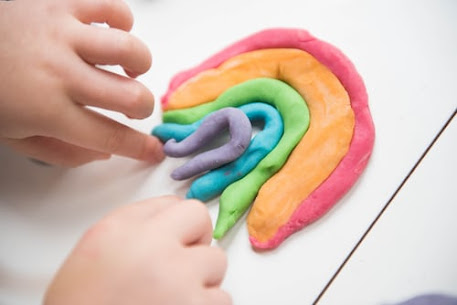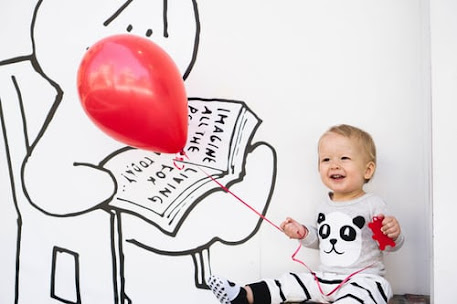Role of Pretend play to develop communication skills in children with ASD
“Children learn as they play. Most importantly, in play children learn how to learn.” - O. Fred Donaldson
What is Play?
Play is can be defined as “any spontaneous or organized activity that provides enjoyment, entertainment, amusement, or diversion” (Parham and Fazio).
One of the major occupations of a child is play— they occupy a majority of their free time to play. It is an important activity for your child because play helps to facilitate positive growth and development.
“Play is our brain’s favorite way of learning.” -Diane Ackerman
Why is Play important?
“The creation of something new is not accomplished by the intellect but by the play instinct.” -Carl Jung
Play is a highly essential part of a child's life. Research has shown that children who participate in play frequently grow quickly, experience higher achievement in school, grow into happy, healthy, confident adults.
Play affects every area of a child's development such as:-
- Physical development (gross motor & fine motor skills)
- Sensory skills development
- Social development
- Emotional development
- Cognitive development
- Communication skills development
Many times, parents think that play is unimportant/less important than studies & often overburden their child with studies, different extra-curricular activities, giving a minimal amount of time to play. Sadly, this hampers the development of a child in many areas.
Play is an essential part of learning not just academics, but the basic skills that we need to have in our everyday lives in order to live to the fullest of our abilities.
Through play, we learn how to
👊 Take our own decisions
👊 Believe in ourselves
👊 Communicate effectively
👊 Solve problems
👊 Taking care of our & other's needs
👊 Be creative
👊 Learn new concepts
There are different stages of play development & different kinds of play. In this vlog, I will be describing "Pretend play/Imaginary play", how that helps in developing the communication skills in children & how you can promote the development of this kind of play.
"Play is the only way the highest intelligence of humankind can unfold"- Joseph Chilton Pearce
What is Pretend play ?
Pretend play can have many names like- imaginative play, creative play, make-believe play, etc.
As the name suggests, pretend play is a form of play in which the child pretends to be any character in a story, or might be role-playing as "mother", or "teacher", or "doctor", etc or might use objects/toys in different ways experimenting in a dramatic fashion.
An example can be:- When a child uses a toy spoon to"feed her doll", or pretending to be "Superman flying" while jumping from the sofa.
Whenever children are participating in pretend plays, they are actively experimenting with different social & emotional roles in life.
Pretend play begins from 11-18months in children.
How does Pretend play help in development of early communication skills?
Research has shown that pretend play encourages the development of early communication skills in children.
If you observe a group of small kids playing a game of "Doctor doctor", or role-playing their teacher, or mother, their interactions can be very amusing to watch!
You will be surprised at their creativity in making the stories, the words & phrases they are using, & the non-verbal expressions while they are enacting the role-play!
Pretend play encourages the development of communication skills by:-
👉 Exposing children to new vocabulary by the different scenarios which they play out
👉 Helps them understand that using words/language skills are essential to put forward your view inorder to be heard & understood
👉 Children learn to choose their words carefully so that others can understand what they are trying to communicate.
👉 Children learn about their likes and dislikes, their interests, and their abilities.
👉 Children learn how to communicate their needs with their friends & also learn to understand the needs of their friends.
👉 By re-enacting different scenarios, they develop social etiquettes & also learn how to solve problems in different scenarios
“Those who play rarely become brittle in the face of stress or lose the healing capacity for humor.” -Stuart Brown, MD
In children with special needs like Autism, ASD, ADHD, SPD, etc imaginative play skills are mostly lacking. They usually have difficulties to express their needs especially to their peers, lack imaginative play skills & socialization skills.
I will describe some simple activities which will encourage these kids to engage in creative/imaginary play thereby will help them to develop the above skills.
Activities to promote Imaginary play skills in children
👉 Guess What?
This is a simple game for beginners. It is easy & fun.
Steps:-
1. Make some chits & write some action words in them.
2. You can take turns to pick up a chit & act out the word.
3. The child has to guess which action word you are doing.
Word can be anything like- Writing, Reading a book, Eating, Drinking water, Singing, Cooking, Brushing teeth, Combing hair, etc.
4. Next round, Ask your child to pick up a chit & act out the word while you guess.
As a variation, if your child can't read the words, you can draw some pictures of the actions.
To make this activity more challenging & fun, You can write the names of any person such as Doctor, Teacher, Shopkeeper, Policeman, or any animal/bird your child is familiar with & act out.
👉 Action with Rhymes
This is another fun activity to promote the development of pretend play in beginners. Whenever we associate any body movement to any activity, our brain learns it much faster.
Steps:-
1. Play any action rhymes
2. Let your child copy the actions from the video.
You can choose rhymes like: Teddy bear teddy bear turn around, Head shoulders knees & toes, Johhny Johhny
3. If copying from the video is difficult, your child can copy the actions from you.
4. When he has learned the rhymes, he can practice singing & acting out the rhymes himself. Make this activity fun by making different sounds & using a lot of gestures.
👉 Use of Playdough
Playdough can be excellent to develop pretend play skills in children. Making different objects/animals using colourful playdough can be an interesting activity for children that enhances their creativity as well as promotes nonverbal & verbal communication skills, problem-solving skills, confidence in themselves.
😃 You can model making some simple designs which they try to copy at first, or, they can use their own imaginations to make something new.
👉 Use of Legos
Similar to the use of play dough, legos can be a great option to enhance creativity, to encourage pretend play & verbal & nonverbal communication skills. Children take delight in creating new objects using their imagination & cognitive skills & love to show off to their family & friends.
😃Appreciating their creation can encourage them to participate more in these kind of pretend play activities.
👉 Use of Toys for Pretend play
- You can begin by modelling some simple, everyday pretend actions that your child can use in pretend play, like driving a car, riding a horse, feeding a doll, or banging a drum.
- 😃Make the games interesting by making sounds of honking by a car while driving your toy car, or tapping of horse.
- 😃Run around with your child pretending to chase him. Take turns to chase each other with a toy car, or riding a horse, etc.
- 😃Children will love to participate if the game seems fun & uses some movements like running, jumping, etc. Incorporating any movements is the best way for a child to learn.
- The lion & the mouse,
- The rabbit & the tortoise,
- The thirsty crow, etc.
- Teacher-students,
- Doctor-patients,
- Shopkeeper-customers, Or,
- Roles in family like Mother-child,
- Father-child, etc.
- Making Salad & serving everyone,
- Making Tea & serving everyone,
- Pretend to take everyone out to a restaurant for dinner,
- Pretend to go with friends to watch a movie, etc.
Tips for making the most of pretend play for
children
Here are some tips to help you and your child get the most out of play:
- 😄 Encourage play in different environments.
- For example, if your child likes playing with Lego at home, encourage your child to play with Lego at a friend’s house or at a relative's house. Reward him for playing and using their skills in different places and with different people.
- 😄 Help your child to develop everyday skills through play.
- For example, dressing a doll or changing in and out of dress-ups can help your child learn to dress themselves.
- 😄 Follow your child’s lead with play.
- Encourage your child to lead the play while you participate in your child’s play, rather than guiding it.
- 😄 Work with your child’s learning strengths.
- For example, if your child is a visual learner, you can work with this strength by using pictures of the different steps in a game or activity.
Pretend play also benefits children hugely in developing their self-esteem and self-awareness. There is a sense of freedom which flows from the realisation that you can be anything by just pretending, and children love this! It’s a safe and secure way to experiment and test boundaries, and build confidence.
Through make believe, pretend play allows children to experience and express both positive and negative feelings. They learn how to modulate the effect of these emotions, how to deal with them positively, how to control their impulses, learn good manners and positive behaviour.
Try out the above simple activities with your child to UNLEASH THE POWER OF IMAGINATIVE PLAY!
Enjoy reading!
Happy parenting to all my readers.😄
About the writer :-
The writer’s name is Abhipsa Parida. She is an occupational therapist specialised in pediatrics and has been handling kids with special needs since 5 years. She is quite experienced and skillful in observation, assessment and planning intervention for kids with special needs. She uses evidence based practice and is very creative and updated in her approach while handling kids with special needs. She has her own clinic in Bhubaneswar and has handled many kids of different age groups with varying needs.
If you have any queries, you can mail them at abhipsaot21@gmail.














It's depicted nicely...your ideas of making the parents learn is always useful... please keep on helping us with your wonderful blogs
ReplyDeleteThank you so much for your appreciation 😊😊
Delete